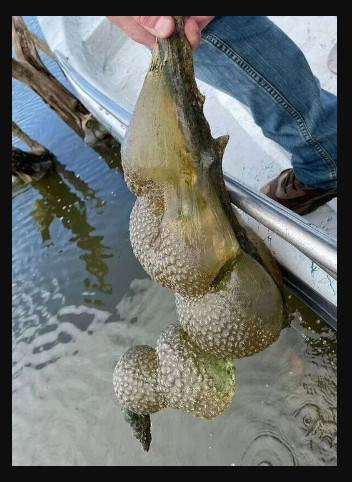Understanding the Mysteries of Bryozoans: Nature’s Alien-Like Aquatic Creatures
In a peculiar turn of events, wildlife officials across the United States have raised awareness among residents regarding the discovery of unusual “alien egg pods” in various lakes and rivers. These bizarre gelatinous structures, often described as jelly-like sacs, are not extraterrestrial invaders but rather a fascinating and harmless group of aquatic organisms known as bryozoans. Their presence has sparked not only concern but also a wave of humorous speculation on social media, with many comparing these organisms to scenes from science fiction movies featuring alien invaders or body-snatching scenarios. As awareness spreads, it becomes increasingly essential to understand what bryozoans are, their ecological significance, and the misconceptions surrounding them.

What Are Bryozoans?
Bryozoans are colony-forming, aquatic invertebrates comprising tiny individual units called zooids. Each zooid is a mere 4 millimeters in size, yet collectively, they can form sizeable structures that can easily be mistaken for alien objects. Historically, bryozoans date back approximately 470 million years, making them one of the oldest life forms on Earth, predating even the dinosaurs. This longevity speaks to their resilience and adaptability within various aquatic ecosystems.
These organisms are often found in freshwater but can also inhabit marine environments. They typically attach themselves to submerged surfaces such as rocks, plants, and even artificial structures like boat hulls and docks. Bryozoans exhibit a range of forms and colors, adding to their unique charm. With over 4,500 described species, these organisms demonstrate an impressive diversity despite their small size. Unlike many creatures in the water, bryozoans possess the unique ability to clone themselves, which enables them to thrive even in challenging environments. They can regenerate lost zooids and expand their colonies, showcasing their remarkable survival strategies.

Lifecycle and Reproduction
The reproductive strategy of bryozoans is equally intriguing. During winter, they produce specialized structures called statoblasts, which serve as survival capsules. These statoblasts can withstand adverse conditions such as extreme cold or drought. When environmental conditions improve in spring, these statoblasts can hatch into new colonies, effectively allowing bryozoans to persist through seasonal changes. This method of reproduction not only contributes to the proliferation of bryozoans but also ensures that they continue to play a vital role in their ecosystems.
Moreover, bryozoans can reproduce both sexually and asexually. In sexual reproduction, male and female zooids generate gametes, leading to fertilization and the development of new zooids, adding genetic diversity to the population. This dual reproductive strategy enhances their adaptability and survival, enabling these creatures to thrive in both stable and fluctuating environments.
Ecological Importance
Despite their slightly off-putting appearance, bryozoans are essential to the health of freshwater ecosystems. They act as filter feeders, straining tiny particles, including algae and organic debris, from the water, which helps maintain water quality and clarity. By consuming excess algae, bryozoans contribute to preventing algal blooms, which can be detrimental to aquatic life and water quality. Furthermore, they serve as a crucial food source for a variety of aquatic life, including snails, mussels, and small fish. Thus, the presence of bryozoans is often an indicator of a healthy aquatic environment, as they thrive in clean waters rich in nutrients.
Interestingly, bryozoans also foster the growth of other aquatic organisms by providing habitat. Their colonies create a complex structure that affords shelter and breeding grounds for various small fish and invertebrates, enhancing biodiversity. The intricate colonies of bryozoans embody a mini-ecosystem, showcasing the interconnectedness of aquatic life.
Public Misunderstanding and Myths
The unusual appearance of bryozoans can lead to misunderstandings among the public, as many may view them as a threat or a sign of pollution. This is largely due to their gelatinous, often eerie look, particularly when found in large masses. However, wildlife agencies, including the Oklahoma Department of Wildlife Conservation, have reassured communities that these organisms are native to North America and do not pose any threat to human health or aquatic life. In fact, their presence is often a sign of a balanced ecological system.
Moreover, some myths suggest that bryozoans are invasive species, which can further exacerbate public concern. It’s essential to clarify that the bryozoans commonly found in North American waters are native species that have coexisted with local flora and fauna for millions of years. Public education about bryozoans’ ecological roles and benefits can help dispel these misconceptions, fostering a more harmonious relationship between humans and these fascinating organisms.
Comparative Analysis with Other Aquatic Organisms
In terms of structural similarities, bryozoans can be likened to coral, albeit more fragile. Both are colonial organisms, but while corals primarily inhabit marine environments, bryozoans are predominantly found in freshwater habitats. The chitinous shells of bryozoans can harden and protect the colony when they dry out, allowing them to survive in less-than-ideal conditions. Their ability to withstand seasonal changes and environmental fluctuations is yet another testament to their evolutionary success.
Bryozoans differ significantly from other common aquatic organisms like sponges and mollusks. Unlike sponges, which filter water through their porous bodies, bryozoans possess specialized feeding structures called lophophores that allow them to capture food particles more efficiently. Moreover, unlike mollusks, which tend to be solitary, bryozoans thrive as colonies, highlighting their unique social structure and cooperative behavior.
The Future of Bryozoans and Environmental Indicators
The future of bryozoans is intrinsically linked to the health of freshwater ecosystems. As environmental challenges such as pollution, climate change, and habitat destruction escalate, the presence and health of bryozoan populations can serve as a critical indicator of ecosystem vitality. Conservation efforts aimed at preserving clean water sources and maintaining natural habitats are essential not just for the survival of bryozoans but for the entire aquatic community they support.
Moreover, ongoing research into bryozoans offers insights into ecological health and sustainability. Scientists study their populations to monitor changes in water quality and to assess the impacts of invasive species or climate change on local ecosystems. As indicators of freshwater health, bryozoans can help guide conservation policies and practices, ensuring that these invaluable ecosystems remain vibrant for generations to come.
Conclusion: A Call for Awareness
In conclusion, while bryozoans may initially appear as alien egg pods to the untrained eye, they are indeed a vital component of our aquatic ecosystems. Their unique reproductive methods, ecological roles, and historical significance underline the importance of understanding and preserving these fascinating creatures. As residents of the United States encounter these gelatinous organisms in their local waters, it is crucial to approach them with curiosity rather than fear, recognizing their role in maintaining a balanced and healthy environment.
By fostering awareness and appreciation for bryozoans, we can contribute to their conservation and the protection of aquatic ecosystems. Encouraging community involvement and education can help dispel myths and promote understanding, ensuring that these ancient aquatic beings continue to thrive amidst the challenges of modern environmental changes.

















